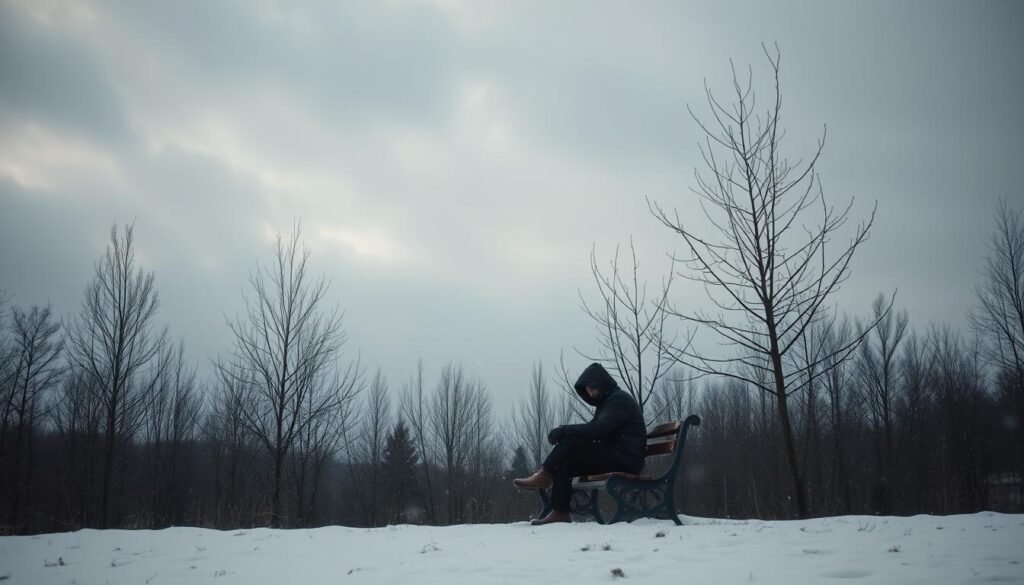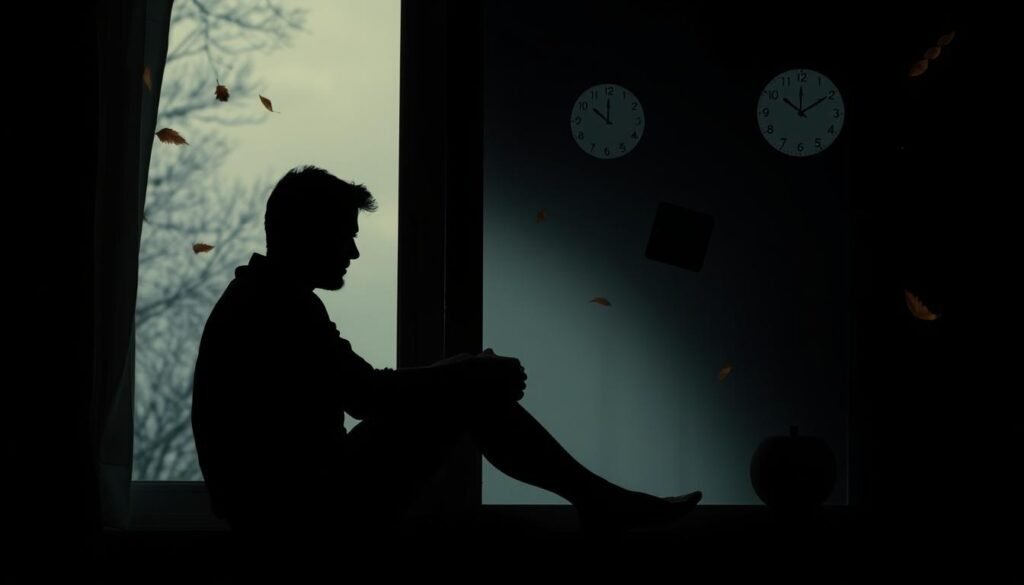About 11 million people in the U.S. may be affected by Seasonal Affective Disorder (SAD) each year. This form of depression appears as the days get shorter in fall and winter. Many feel persistently low and lethargic due to changing weather and light patterns. It’s key to understand the causes and symptoms of SAD to maintain mental health.
Seasonal Affective Disorder impacts many, causing sleep issues and changes in eating habits. While SAD is often linked to dreary winter weather, some experience relief during these months. Instead, they face symptoms in warmer seasons. It’s also found that SAD can run in families, showing genetics’ role.
Recognizing how weather impacts mood is crucial, as less sunlight can lead to SAD symptoms. Thankfully, there are treatments like light therapy and cognitive behavioral therapy. These can ease the tough effects of SAD. We’ll explore more about Seasonal Affective Disorder, its causes, symptoms, and how to cope in the next sections.
Key Takeaways
- About 11 million people in the U.S. are affected by Seasonal Affective Disorder annually.
- Symptoms can include low mood, lethargy, and changes in appetite.
- Decreased sunlight during shorter days is a common trigger for SAD.
- Genetics play a role in vulnerability to Seasonal Affective Disorder.
- Light therapy and cognitive behavioral therapy are effective treatments.
Understanding Seasonal Affective Disorder (SAD)
Seasonal Affective Disorder (SAD) happens when depression is tied to the seasons. Most people start feeling down in the fall. This feeling gets worse through December, January, and February. When spring comes, they usually feel better.
Knowing if someone has SAD can be tough. The signs are a lot like other kinds of depression. Doctors look for patterns of depression that come back year after year. They also make sure nothing else is causing the feelings. SAD affects 1% to 2% of people, especially women and the young.
Everyone with SAD feels differently. Some common signs are:
- Low mood
- Lack of interest in activities
- Irritability
- Feelings of guilt and low self-esteem
- Sleep disturbances
- Changes in appetite
- Lethargy
Some people with SAD might deal with severe depression. Things like genes, past experiences, who you are, and where you live can play a part. Places far from the equator have less sunlight in winter, leading to SAD.
There’s also a lighter form called “winter blues” that impacts 10% to 20% of people. Treating SAD can include therapy, medicine, and light therapy. It’s important to take SAD seriously because it can really affect your life.
Causes and Symptoms of SAD: How Weather and Light Affect Mood
Seasonal Affective Disorder (SAD) is deeply connected to yearly environmental conditions. The mix of weather and light really matters for people with mood issues. With less sunlight in fall and winter, SAD gets more common, affecting mood and overall happiness.
The Role of Sunlight in Mood Regulation
Sunlight plays a key role in keeping our moods steady by affecting serotonin production. When there’s less sun in the cold months, we might have lower serotonin. This can make SAD symptoms worse. The lack of light messes with our sleep and body clock, making us feel sadder and more tired.
Women are especially likely to get SAD, being three times more at risk than men.
Impact of Seasonal Changes on Mental Health
The shift in seasons does more than change the weather; it also sparks symptoms of mood disorders. Around 11 million Americans deal with seasonal depression. This shows how the changing seasons really impact our mental well-being.
People in the north, where winters are long and dark, are more likely to get SAD. Studies show that 5% of people face this condition every year.

But summer can bring the “summer blues” for some, the opposite of winter SAD. This affects about 10% of those with SAD and comes from too much sun. Understanding these trends helps grasp the full picture of SAD, showing how vital sunlight is for our mood.
Symptoms of SAD: Recognizing the Signs
Seasonal Affective Disorder (SAD) has signs that depend on winter-onset or summer-onset patterns. Knowing these signs is key for diagnosing and helping those affected.
Common Symptoms of Winter-Onset SAD
Winter Depression shows several clear symptoms. People often feel:
- Persistent feelings of sadness or hopelessness
- Low energy levels and increased fatigue
- Cravings for carbs leading to weight gain
- Too much sleep and hard waking up moments
- Less social activity and interest in fun
These symptoms of SAD can make daily life hard. Early noticing and help are critical. If these symptoms appear, it’s important to see a healthcare pro for the right treatment.
Characteristics of Summer-Onset SAD
On the other hand, Summer Depression brings different issues. Major signs include:
- Insomnia or trouble sleeping at night
- Less hunger and possible weight loss
- Feeling more irritable and agitated
- Anxious feelings
Knowing both winter and summer symptoms helps people spot their own SAD issues. This understanding leads to better ways to cope and get treatment. For more insights, check out this resource.

How Weather Affects Mood: The Science behind SAD
The link between weather and mood is quite interesting when talking about Seasonal Affective Disorder (SAD). This disorder is affected by light and seasonal changes. We need to look at how our bodies react to different amounts of natural light.
Circadian Rhythms and Seasonal Changes
Circadian rhythms help regulate our daily functions, like sleeping and mood. The brain area called the hypothalamus controls these rhythms and reacts to light levels. In shorter days, we might have less serotonin, which helps keep our mood steady. This can lead to problems, including mood disorders.
Up to 30% of people may experience meteoropathy, where weather changes cause symptoms like irritability and sleep issues. This affects their mental health.
The Relationship Between Light Exposure and Serotonin Levels
Light exposure affects how much serotonin our bodies make, which can change our mood. Studies show sunlight increases serotonin and makes us feel better. But less light decreases serotonin. Before storms, drops in atmospheric pressure might stress some people, worsening mood disorders. This is hard for those already struggling, especially in winter.
Some light patterns might help, similar to light therapy used for SAD. While sunny days help some, overcast weather can be tough for others. Knowing how weather affects mood is useful for managing mood disorders. For more, visit this informative resource.
Risk Factors for Developing SAD
It’s critical to know who might get SAD. Many factors make someone more likely to have it. Genetics and where you live are big reasons why some get SAD.
Genetic Predispositions to SAD
Genes play a big part in getting SAD. If depression or bipolar disorder runs in your family, you’re at higher risk. Studies show SAD is common in younger females. Knowing your family’s mental health history helps catch SAD early.
Geographic and Environmental Influences
Where you live affects SAD risk. Places far from the equator have shorter days in winter, raising SAD cases. For instance, Canada and Alaska see more SAD than sunny Florida does.
Your lifestyle and environment also matter. Spending too much time inside or working odd hours can make you more prone to SAD. This is because you get less sunlight.
| Risk Factor | Impact on SAD |
|---|---|
| Family History of Mental Health Conditions | Increases susceptibility |
| Geographic Location | Higher rates in northern regions |
| Gender | More common in females |
| Age | More prevalent in younger individuals |
| Indoor Lifestyle | Reduced exposure to sunlight |

Treatment Options for Seasonal Affective Disorder
Finding the right treatment for SAD is very important. People experience it during the darker months. Treatments like light therapy, psychotherapy, and medications are helpful. They are chosen based on what a person needs.
Light Therapy as a Treatment Method
Light therapy is a top choice for SAD symptoms. It involves daily use of a special light box each morning. About 30 minutes of this can help adjust melatonin and serotonin levels, improving mood.
Many see their symptoms get better in just a week. Regular use is best for good results. Side effects like feeling jittery or having eye strain are minor and go away fast.
Psychotherapy and Medication
Psychotherapy, especially Cognitive Behavioral Therapy (CBT), is key for SAD treatment. It means meeting with a therapist for a few weeks. CBT fights negative thoughts that come with seasonal changes. The National Institute for Health and Care Excellence (NICE) supports this method for depression too.
For those not fully helped by light or talk therapy, SSRIs might work. These antidepressants take about a month to work best. One should keep taking them as their doctor says.
For those wanting to dig deeper into SAD treatments, looking into different therapies is smart. It helps find the best option for you.
Effective Lifestyle Changes to Manage SAD
Managing Seasonal Affective Disorder (SAD) is crucial and can be done with key lifestyle changes. Adding physical activity and healthy eating can make a big difference. Activities that get you outside and in the sunlight help a lot. It’s also important to make sure you’re getting enough vitamin D.
Importance of Exercise and Outdoor Activities
Exercise can really help improve your mood and fight depression. When you exercise outside, like walking, jogging, or biking, you get natural light. This sunlight can help make you feel happier and more positive.
- Engaging in outdoor sports can boost endorphins.
- Routine workouts can improve sleep patterns and energy levels.
- Spending time in nature has been shown to lower stress levels.
- Participating in group activities fosters social connections.
Making these changes if you have SAD can really help your mental health. It inspires you to seek the sunlight that makes you feel better.
Dietary Considerations and Vitamin D
Your diet has a big impact on your mood and mental health. Eating foods high in vitamin D is good if you have SAD. This vitamin is key for feeling happy because it helps serotonin work better. Try to eat these foods often:
- Fatty fish (salmon, mackerel, sardines)
- Fortified dairy products
- Egg yolks
- Mushrooms exposed to sunlight
If you don’t get much daylight where you live, you might need vitamin D supplements. A balanced diet, along with lifestyle tweaks for SAD, can really improve how you feel every day.
When to Seek Professional Help
Knowing when to seek Professional Help for SAD is crucial. It’s key for people battling Seasonal Affective Disorder. Watch your emotions and behaviors, especially during fall and winter. This is when SAD can get worse.
Signs that Indicate Professional Treatment is Needed
There are several signs that show you might need professional help. These signs include:
- Feelings of hopelessness that don’t go away
- Constant sadness or irritability that disrupts everyday life
- Big changes in how much you eat or your weight
- Problems with sleeping too much or not enough
- Avoiding friends and activities you used to enjoy
- Using alcohol or other substances to feel better temporarily
Getting help early can really improve how you handle SAD, making you feel better overall. By reaching out to mental health professionals, you’re taking a big step. They can do tests and evaluations to find the best way to treat these Signs of Depression.
Conclusion
Understanding Seasonal Affective Disorder (SAD) helps with better mental health management. It’s especially important for those dealing with seasonal depression. Symptoms like fatigue and social withdrawal show up mainly in the colder months. This makes it hard for people to cope.
Among 34 million Americans aged 65 and over, more than two million suffer from depression. This highlights why knowing about and treating this issue is key.
To manage SAD, using light therapy and psychotherapy, like Cognitive-Behavioral Therapy (CBT), works well. Adding lifestyle changes is also crucial. People need to act early on their mental health and get professional advice when things get tough. A detailed check by a mental health expert can pinpoint the problem. This leads to better treatment and a happier life.
The first step in caring for oneself is to see how weather affects mood. To stay emotionally well all year, look for ways to fight off the darkness, especially if you live far from the equator. For extra details on Seasonal Affective Disorder, check out this resource. Tackling these elements can really help reduce the sting of seasonal depression.